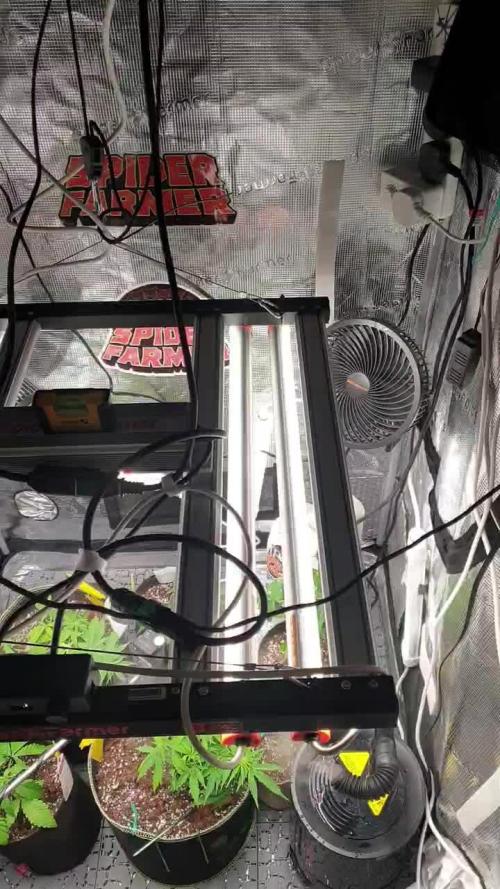The Grow Awards 2026 🏆 































Likes
Comments
Share


@UnkleSkunk
Follow
Siamo alla fine i tricomi diventano ambrati ancora qualche giorno val taglio
Likes
29
Share


@CanadianFillmore
Follow
Harvest day for super lemon haze, fuck yeah!! This strain with 50% the nute dosage levels, did amazing compared to previous SLH grows. Bigger, denser buds, just less lemon citrus smell. I'll update in 7-10 days with dry weight and smoke test.
Thanks you for following this grow, I hope you liked it 👽🌳💚
Nov 15 - dry weight of 76 grams, minus a gram for test smoke.
This little plant did pretty well for being a runt that struggled to grow in size since she was cut as a clone and rooted. Running at 50% nutes levels, I feel, was a good thing. The smoke is smooth, with a light lemon citrus taste and smell. It burns well, evenly throughout the joint and has a nice ash (medium gray/white). Still my favorite strain and I will grow again!
Likes
26
Share


@APOLLO
Follow
This is nuts lol 😆
I may have fast forwarded through the pictures, apologies, they are loads and more difficult to work through. Consider a week and a half missing from flowering so far.
She is not close to finishing yet as far as I can tell. As new white hair are growing, very obviously. the orange hair is quiet a few but they were kind of there all along.
Smell is sweet fruity but not as powerful yet. Buds are sticky and solid, Every cola is sticky, solid and huge and still growing.
Likes
7
Share


@Karl_Heinz420
Follow
Original Sensible Seeds - Frosted Guava 🍈
Enjoy - Week 8 👨🏻🌾❄️
- 25-28 grad Celsius
- 55-60% humidity level
- 20l Air-Pot
(75% BioBizz All-Mix, 25 % BioBizz Worm Humus)
- RO-water (PH 6,25)
Day 50 👨🏻🌾 Frosted Guava
- LST
Sanlight Evo 3-60 40%: about 400 PPFD
Spider Farmer Glow30 6h/18h on
Processing
Likes
2
Share


@nodesign
Follow
I changed the water and raised the nutrients this week, I'm going to start 12/12 today. Not much to report but they're growing fast, power plants are already out pacing the rest like last time.
Likes
5
Share


@TheBulldozerSicily
Follow
Rimettiamo il telone ma questa volta trasparente, la pianta continua a crescere e fare fotosintesi ma sopratutto sono al sicuro se piove, non vorrei rischiare di rovinare tutto proprio alla fine, anche la più stupida pioggiarella a questo stadio della pianta potrebbe fare tantissimo danno.
Likes
10
Share


@Holden_out2020
Follow
Had a lil fun this week letting them grow on out a bit before I take cuttings
Likes
2
Share


@KannaGrowing
Follow
Estamos en la tercera semana de crecimiento vegetativo.
Nuestras plantas ya tienen unos 15 centímetros aproximadamente, y han superado la fase crítica.
Recordamos que hasta ahora solo estamos regando con agua, aún no hemos incorporado los fertilizantes.
Seguimos manteniendo la humedad relativa bastante alta, y la temperatura entre 22 y 24ºC.
Pero aumentamos la potencia al 50% de ambas luminarias.
Likes
9
Share


@Dgessy
Follow
La Petite fille a atteint sont potentiel en taille, maintenant j'attends le mûrissement des têtes 👍😊 Le ratio fleurs/feuilles est super !!! De beaux calices et pas beaucoup de feuilles 😊 Le soleil est toujours au rendez-vous, rarement il fait autant beau dans ma région à cette période de l'année.
Likes
22
Share


@ButterfliesLittleFarm
Follow
Hello Diary.
The fifth week of flowering is over, and Fat Banana is slowly completing its cycle. Ten more days and we have a harvest. 😍
The “farm” is a real jungle, her roommates Haze Berry Auto have grown quite big but I think Fat Banana Auto will be leaving the “Farm” sooner. 😀
All the larger leaves on the plant have turned yellow and got pretty big brown spots, is it due to some problems caused by my treatment or is Fat Fat Banana just coming to the end of its cycle? I'm not entirely sure. (lack of experience) 😏
The flowers themselves look healthy, and smell like the finest sweets. The sweet-fruity scent overwhelms me as soon as I open the box. 😋
The flowers are compact and very sticky, as far as I can see now, it will be a good harvest. 💪
As we approached the end, I stopped adding nutrients and watered only with water to which I only regulated p.H. at 6.4.
In my case, it's a reduction because my house water is around 7.5 - 8.1 p.H, so I use Plagron's Lemon Kick for the descent, which does a good job. 👌
Here's what the week looked like.
15/11/2020 - Day 52.
Watering. Only water, without any nutrients with regulated p.H. at 6.4
Temp / Humidity on the farm - 25.5 degrees and 47% humidity.
18/11/2020 - Day 55.
Watering. Procedure as three days earlier.
Temp / Humidity on the farm - 25.2 degrees and 48% humidity.
19/11/2020 - Day 56.
Photographing plants. As always, on the last day of the current week I am taking photos of “my little farm”. 😉
That’s it for this week, a little more and I will enjoy the fruits of the effort these past weeks. Thanks to everyone who takes a look at the diary and I hope that this information will be useful to someone. See you soon. 🙌
Likes
6
Share


@Beanz2Budz
Follow
These were brought on from seed planted straight into plastic 1litre containers and keep in the environment for around the first 3 days before transplant into their final pot.
Likes
45
Share


@Mosquito_Haarlem
Follow
Heerlijke harde volle toppen en voor het eerst dat ik harsdruppels zie.
Een heerlijke strain om te growen.
De plant wordt in zijn geheel opgehangen en ik zal het droge gewicht wegen.
Likes
11
Share


@BudBeezy
Follow
Now that the plant is dry, I can go into a few more details.
In my opinion, the harvest is a complete success for a beginner.
During the harvest I realised how hard the flowers are. After drying, they became even harder, almost rock hard. The flowers are covered with many shiny trichomes.
The harvest took quite a long time. I spent about 14 hours on it, which was also due to the super meticulous wet trim. The reason for the thorough wet trim was the mould. Every single flower was examined. I disassembled the large flowers before drying to be on the safe side. It's nice to have huge flowers, but in the end they are chopped up anyway.
At the end of the 8 days of drying, the GG4 Sherbet FF rewarded me with finest ice-coated flowers. Thanks to the wet trim, I didn't have to do any more work. I was able to separate the buds directly from the branch and put them in the jars to mature. As the offcuts were also super potent due to the thorough wet trim, I processed them into butter.
Likes
Comments
Share


@Gozdzias87
Follow
The plants are a bit sluggish. I overfed them with Cal-Mag and they stopped taking in other nutrients. Amnesia and Purple Queen had spots on their leaves and were pale. I watered them twice with Bio Grow pH 5.8 and they were back in action after 3 days. I have no complaints about the auto. They have started flowering.
Likes
2
Share


@Selkot
Follow
.
YEAR 5 - 1st quarter
----------------------
The 5th season begins with the same setup.
The novelty of this season is the substrate: from this point on, all my indoor grows will be done in coco coir.
Five Northern Lights plants, 2 from RQS indoor and 3 from Zamnesia outdoor, take up the first quarter.
With 5 plants, they will produce 212 g.
For the first time, one of them alone exceeds 100 g.
Likes
27
Share


@LockDownGrow
Follow
This lady is just about ready too come down , I will get her down tomorrow
Smell is strong and she is frostie as hell ,
She has been in darkness for 3 days now so she will be chopped down on day 6 of week 11 :)























